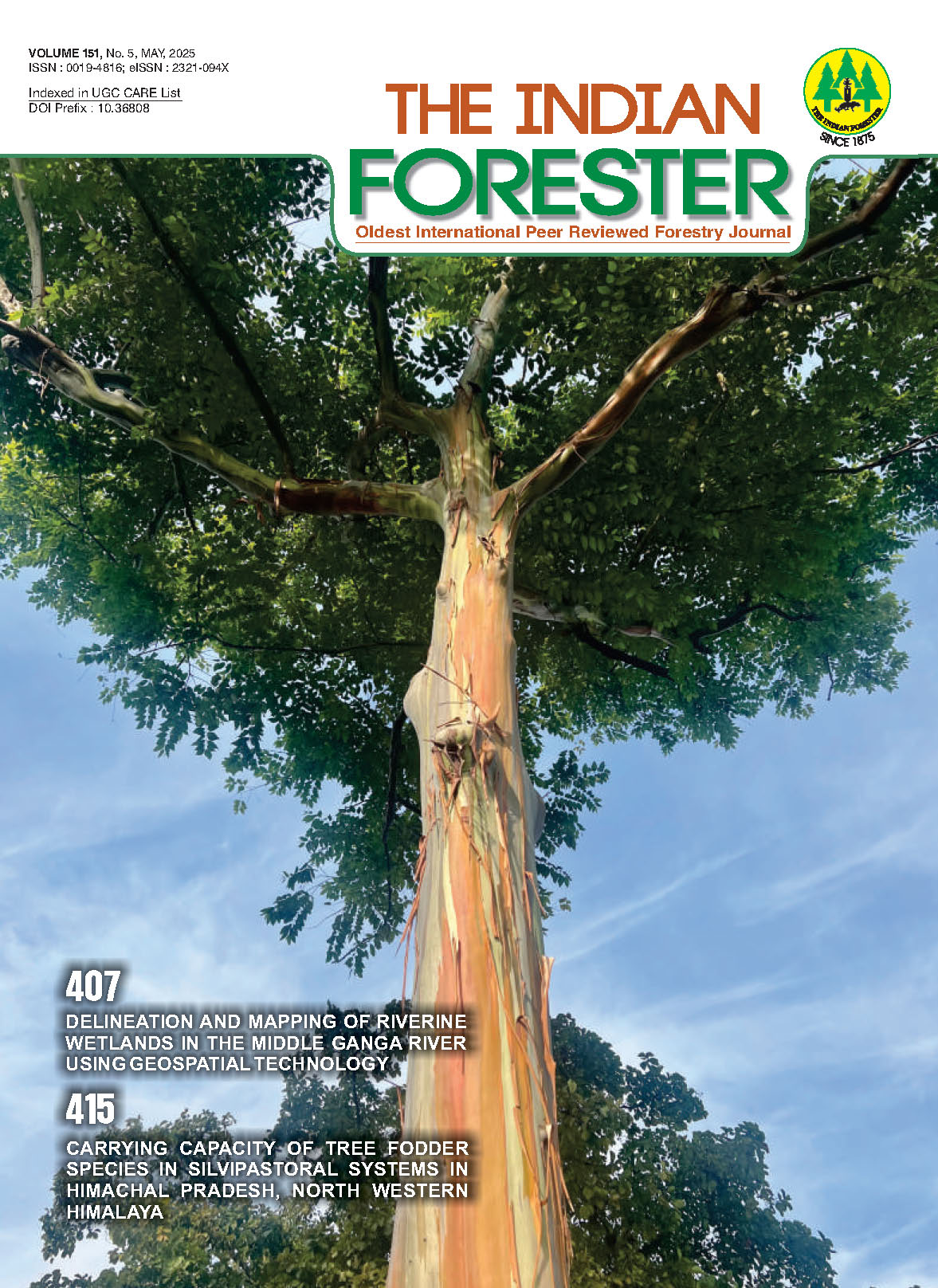Delineation and Mapping of Riverine Wetlands in the Middle Ganga River using Geospatial Technology
DOI:
https://doi.org/10.36808/if/2025/v151i5/170762Keywords:
Riverine Wetland, Floodplain, Habitat, Biodiversity, Mapping.Abstract
The wetlands are natural sink of pollutants and provides ecosystem services worldwide. Rapidly declining water resources is a global concern, underscored by international conventions such as the Ramsar Convention on Wetlands. The riverine wetlands are located at river floodplain and seasonally connected with the main stem river. Delineation and mapping of these wetlands are important to visualize their distribution pattern. We conducted the study in the middle Ganga River using geospatial techniques to delineate and map riverine wetlands. Result shows the wetlands are distributed along the active river channel in the Ganga River floodplain, which are seasonally connected with the Ganga River in monsoon. The wetlands are replenished with nutrients during fluvial connectivity. Wetlands are delineated and mapped (n=788) using Landsat 8 OLI satellite image by Modified Normalized Difference Water Index (MNDWI) by separating the water and land area using green and short wave infrared spectral bands of satellite image. These wetlands are home to various aquatic and water associated avian species, amphibian and reptiles. Conservation measures for these riverine wetlands are essential for sustainability of wetland ecosystem and wetland inhabiting flora and fauna and rejuvenation of the Ganga River system. Some of the wetlands are declared as protected area and Ramsar conservation sites, whereas more wetlands are need to be conserved under national conservation authority to conserve their natural integrity and to protect its biodiversity. This study provides insights and framework for freshwater habitat management for aquatic biodiversity.
References
Grazie F. and Gill L. (2022). Review of the Ecosystem Services of Temperate Wetlands and their Valuation Tools. Water. https://doi.org/10.3390/w14091345. DOI: https://doi.org/10.3390/w14091345
Guo M., Li J., Sheng C., Xu J. and Wu L. (2017). A Review of Wetland Remote Sensing. Sensors, 17, 777. doi:10.3390/s17040777. DOI: https://doi.org/10.3390/s17040777
Haider A., Hassan M. and Rasib A. (2023). Geospatial approach to wetland vulnerability assessment for northwest Bangladesh. The International Archives of the Photogrammetry, Remote Sensing and Spatial Information Sciences. https://doi.org/10.5194/isprs-archives-xlviii-4-w6-2022-139-2023. DOI: https://doi.org/10.5194/isprs-archives-XLVIII-4-W6-2022-139-2023
Jia M., Mao D., Wang Z., Ren C., Zhu Q., Li X. and Zhang Y. (2020). Tracking long-term floodplain wetland changes: A case study in the China side of the Amur River Basin. International Journal of Applied Earth Observation and Geoinformation, 92: 102185. https://doi.org/10.1016/j.jag.2020.102185. DOI: https://doi.org/10.1016/j.jag.2020.102185
Kadykalo A. and Findlay C. (2016). The flow regulation services of wetlands. Ecosystem services, 20: 91-103. https://doi.org/10.1016/J.ECOSER.2016.06.005. DOI: https://doi.org/10.1016/j.ecoser.2016.06.005
Kumar D., Kumar A., Malik D., Sharma R., Gupta V. and Kumar P. (2023). Effect of Barrages and Anthropogenic Activities on Ecological Integrity of the Ganga River: A Review on Current Issues and Restoration Efforts. AgroEnvironmental Sustainability. https://doi.org/10.59983/s2023010109. DOI: https://doi.org/10.59983/s2023010109
Mpandeli S., Liphadzi S., Mabhaudhi C., Mabhaudhi T. and Nhamo L. (2024). Assessing the Impact of Anthropogenically Modified Land Uses on Wetland Health: Case of Witbank Dam Catchment in South Africa. Water. https://doi.org/10.3390/w16162287. DOI: https://doi.org/10.3390/w16162287
Mukherjee K. (2020). Wetland habitat stability assessment in hydro-geomorphological (HGM) and surface water availability (SWA) conditions in a lower Gangetic floodplain region of Eastern India. Ecological Indicators, 119: 106842. https://doi.org/10.1016/j.ecolind.2020.106842. DOI: https://doi.org/10.1016/j.ecolind.2020.106842
National Wetland Atlas: INDIA, (2011). SAC/EPSA/ABHG/NWIA/ATLAS/34/2011, Space Applications Centre (ISRO), Ahmedabad, India, 310p.
Ozesmi S. and Bauer M. (2002). Satellite remote sensing of wetlands. Wetlands Ecology and Management, 10: 381-402. https://doi.org/10.1023/A:1020908432489. DOI: https://doi.org/10.1023/A:1020908432489
Rodgers W.A., Panwar H.S. and Mathur V.B. (2002). Wildlife Protected Areas in India: A Review (Executive Summary). Wildlife Institute of India, Dehradun.
Singh M., Sinha R., Mishra A. and Babu S. (2022). Wetlandscape (dis)connectivity and fragmentation in a large wetland (Haiderpur) in west Ganga plains, India. Earth Surface Processes and Landforms, 47: 1872 - 1887. https://doi.org/10.1002/esp.5352. DOI: https://doi.org/10.1002/esp.5352
Sinha R., Saxena S. and Singh M. (2017). Protocols for Riverine Wetland Mapping and Classification Using Remote Sensing and GIS. Current Science, 112: 1544. https://doi.org/10.18520/CS/V112/I07/1544-1552. DOI: https://doi.org/10.18520/cs/v112/i07/1544-1552
Uzarski D., Bosch A. and Cooper M. (2009). Wetland Ecology and Management for Fish, Amphibians and Reptiles. 582-589. https://doi.org/10.1016/B978-012370626-3.00059-4. DOI: https://doi.org/10.1016/B978-012370626-3.00059-4
Xu X., Chen M., Yang G., Jiang B. and Zhang J. (2020). Wetland ecosystem services research: A critical review. Global Ecology and Conservation, 22. https://doi.org/10.1016/j.gecco.2020.e01027. DOI: https://doi.org/10.1016/j.gecco.2020.e01027
Downloads
Downloads
Published
How to Cite
Issue
Section
License
Unless otherwise stated, copyright or similar rights in all materials presented on the site, including graphical images, are owned by Indian Forester.





